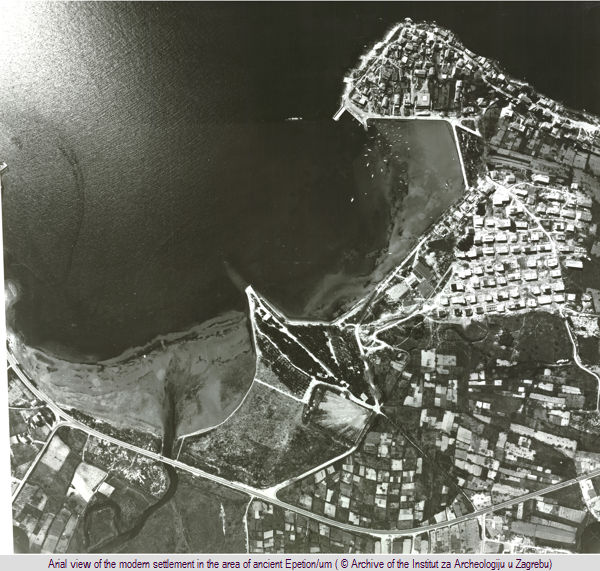Epetion was situated 5km SE from the modern city of Split, in Middle Dalmatia. Today, the coastal community of Stobreč, harbors the ancient remains. Epetion was founded on a geographically favorable position, a small peninsula (4ha), surrounded by the Adriatic sea, in the vicinity of the biggest fertile land in the area. The peninsula encloses a large bay, used as a harbor. The mouth of river ˇrnovnica ends in the bay, therefore provided a direct communication with the hinterland. Epetion was mentioned in several ancient sources, the most prominent one being Polybius (Pol XXXII 9,1). We can assume that this settlement could have been one of localities from where Greek material culture, but also its civilization developments emanated into the Dalmanian hinterland and perhaps even beyond.
In the past, several scholars have given some attention to Epetion, mostly in documentation of the ancient remains, and a few rescue interventions, but systematical, or more recent archeological research is lacking [1]. The only published archeological excavations are from the 70s when the city fortification with the N gates was investigated [2].

In 2012 the Croatian Archeological Institute and Institut für Archäologie der Karl-Franzens-Universität Graz started an archaeological and interdisciplinary project whose aims are investigations of Stobreč in order to reconstruct topography and history of the ancient settlement, with respect to modern topography; and of ancient landscape (including the bay). The primary focus in the first year will be the Hellenistic fortification, whose original fragments have been preserved on the N side. As a part of preparatory work, in collaboration with the Institut für Geographie und Raumforschung der Karl Franzes Universitat Graz a non destructive method (GPR) was used to investigate the area in the front and behind of the remains of the N fortification walls. The results have revealed certain structures, which are to be investigated further. The private collection of findings, from Stobreč, owned by the local family Cokarić was documented. Further research in this, and following years will focus on systematic excavations, interdisciplinary approach with emphasis on geology and geography, and documentation of all available information.
[1] B. Kirigin, Epetij, Antički Grci na tlu Hrvatske, 2010, 142-143.
[2] A. Faber, Bedemi Epetiona-Stobreč kod Splita, Prinosi Instituta za arheologiju 2, 1983, 17- 37.
![]() © Tina Neuhauser, Marina Ugarković
© Tina Neuhauser, Marina Ugarković
e-mail: tina.neuhauser@uni-graz.at, marina.ugarkovic@zg.t-com.hr
This article should be cited like this: T. Neuhauser - M.Ugarković, Epetion, Forum Archaeologiae 63/VI/2012 (http://farch.net).